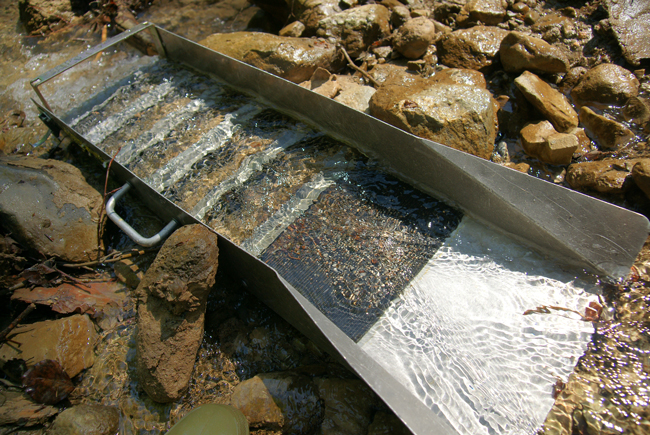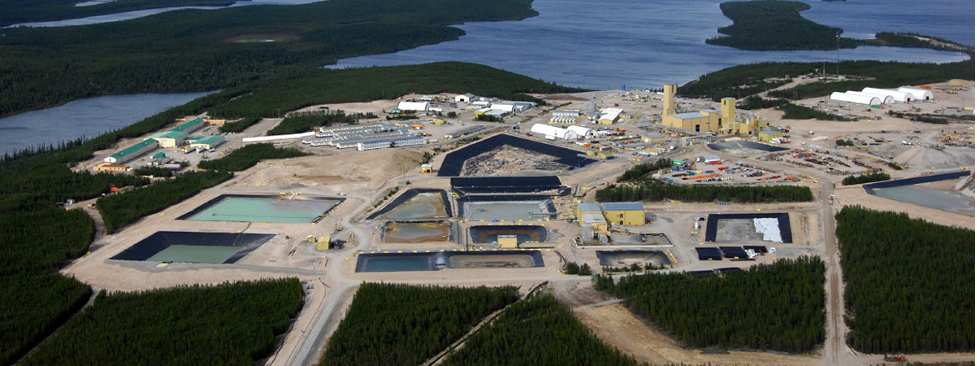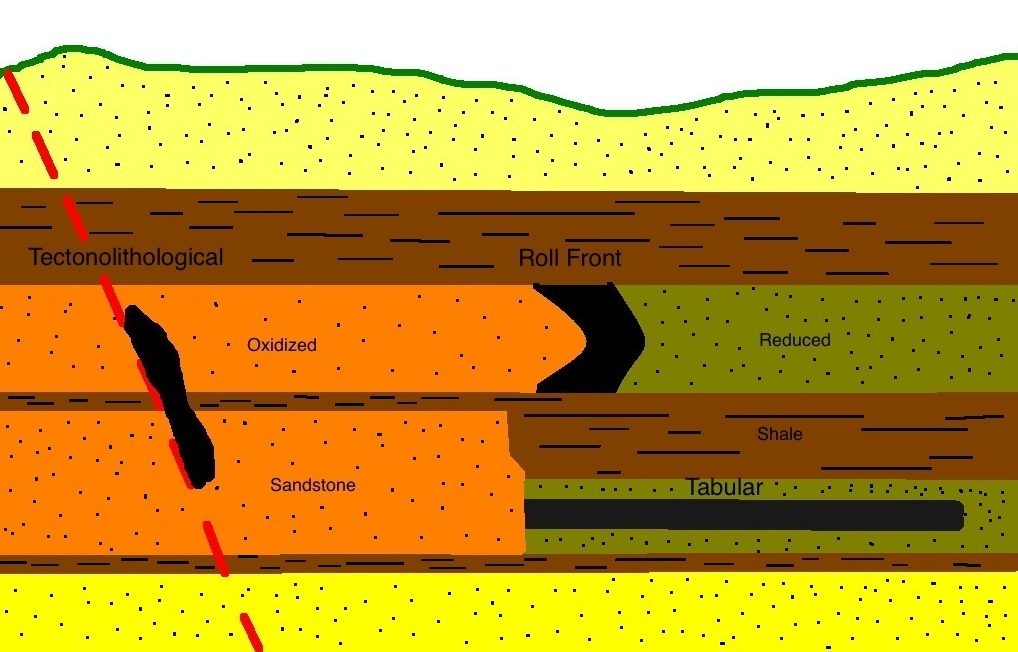This probably explains why Bayfield is finding base metal mineralization and high gold-silver grades in the Burns Block drilling. Just like in real estate; location, location, location is important when exploring for minerals.
[box type=”info” align=”aligncenter” ]Disclaimer: This is an editorial review of a public press release and not an endorsement. It may include opinions or points of view that may not be shared by the companies mentioned in the release. The editorial comments are highlighted so as to be easily separated from the release text and portions of the release not affecting this review may be deleted. Please view the full release here.[/box]
VANCOUVER, BRITISH COLUMBIA–(Marketwired – Oct. 9, 2013) – Bayfield Ventures Corp. (TSX VENTURE:BYV)(PINKSHEETS:BYVVF)(FRANKFURT:B4N) is pleased to announce further assays results from the continuing exploration drill program at the Company’s 100% owned mineral rights Burns Block gold-silver project. The Burns Block is located adjacent to the east of New Gold’s multi-million ounce Rainy River gold-silver deposit and adjacent to the west of New Gold’s expanding Intrepid gold-silver zone, Rainy River district, north-western Ontario.
[box type=”note” align=”aligncenter” ]Below are maps showing the location of the Rainy River district and its regional setting.[/box]
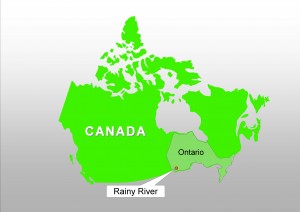

[box type=”note” align=”aligncenter” ]Here is a map of gold mineralized zones within the Rainy River district. It shows that Bayfield’s gold zones lie along strike of New Gold’s multi-million ounce gold deposits.[/box]
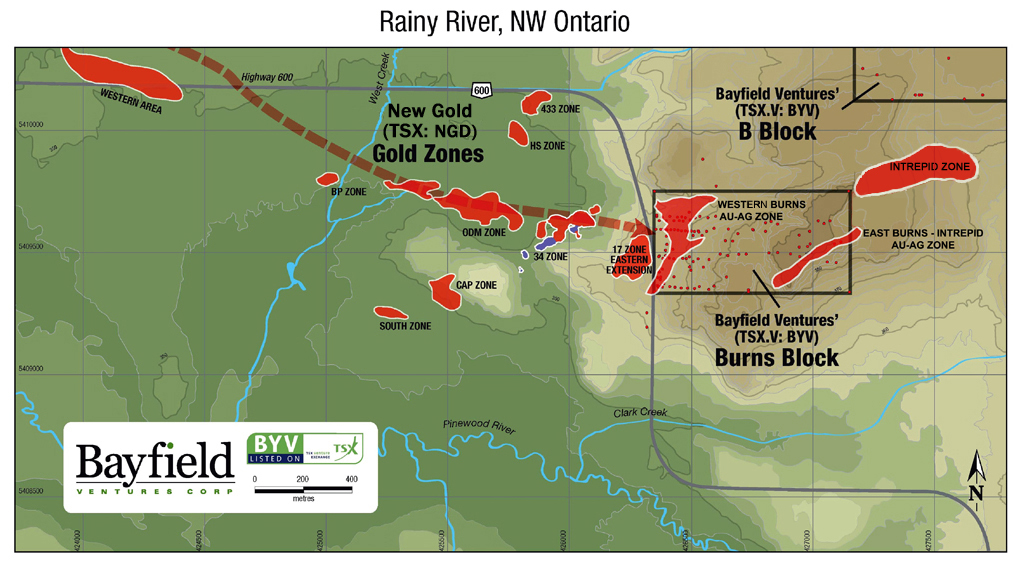
Highlights:
- Hole RR13-11W1 intersected 30 metres of 4.05 g/t gold and 15.29 g/t silver
- Hole RR13-11W1 includes a high grade zone of 6 metres of 14.34 g/t gold and 61.40 g/t silver
- Assays pending for completed wedge holes RR13-11W2 and RR13-11W3
- Extension down plunge drilling continues at East Burns Intrepid Zone further southwest
Strong, poly metallic base metal veining has been intersected in all completed holes. Gold and silver assays for wedge hole RR13-11W1 is summarized in the table below.
[box type=”note” align=”aligncenter” ]The geology map below obtained from Bayfield’s corporate website shows an important piece of information. If you look closely you can see that there are zones of east-west and north-south trending shears. The Burns Block is right where they intersect. Where major deep seated structures intersect like this voids are formed within the crust where mineralized hydrothermal fluids can be injected into. This probably explains why Bayfield is finding base metal mineralization and high gold-silver grades in the Burns Block drilling. Just like in real estate; location, location, location is important when exploring for minerals.[/box]
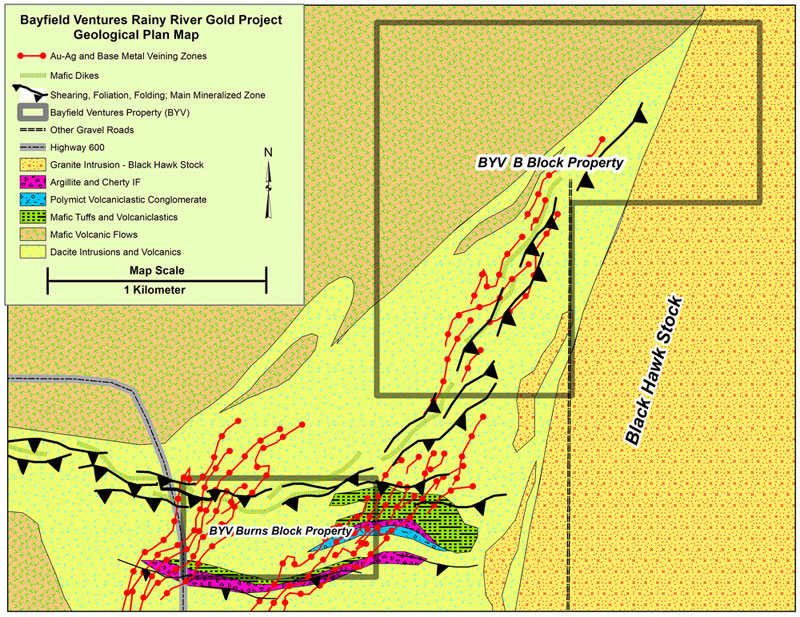
Results of Intrepid Zone Extension Exploration and Near Term Exploration Plans:
The Intrepid gold-silver zone on Bayfield’s Burns Block is being significantly extended down plunge by the Company’s current exploration program.
Previously reported mother hole RR13-11 returned a bonanza grade interval from 679.0 to 680.5 metres down hole of 528 g/t (18.63 oz/t) gold and 103 g/t silver over 1.5 metres within a 7.5 metre mineralized zone. Hole RR13-11 intersected the strong gold mineralization in a position 25 metres down plunge of the mineralized zones in previously reported assays from the RR12-34 mother hole and wedge complex. This well-developed zone in hole RR13-11 contained highly deformed, quartz-galena-gold and poly metallic base metal veins and veinlets.
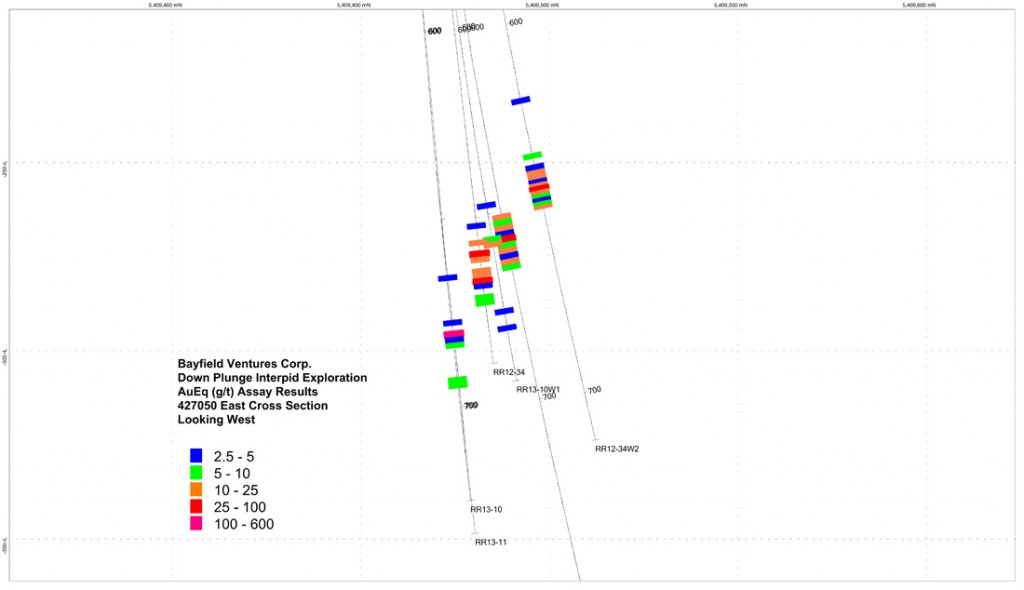
[box type=”note” align=”aligncenter” ]The above cross-section shows the gold grades every metre in some drill-holes through the Intrepid Zone. This looks really promising due to a number of the drill-holes in the zone having good grades and widths. It looks like Bayfield has located a high grade ore shoot. Luck must be on their side because these things are normally tricky to find. Their long pencil-shape geometry within a lower grade zone of mineralization usually makes them a hit and miss affair when trying to drill them.[/box]
Wedge hole RR13-11W1 returned 4.05 g/t gold and 15.29 g/t silver over 30 metres including a high grade interval from 671 metres down hole of 14.34 g/t gold and 61.40 g/t silver over 6 metres. The intersection in hole RR13-11W1 is 12 metres above and to the east of previously announced mother hole RR13-11. The zone in hole RR13-11W1 encountered locally abundant visible gold localized within cracks in highly deformed white to grey quartz-galena-pyrite veinlets and veins. The galena is locally abundant and has a strong spatial association with observed native gold.
Three wedge holes from the RR13-11 mother hole have been completed in Bayfield’s continuing down plunge Intrepid Zone exploration at the Burns Block. Assays for wedge holes RR13-11W2 and RR13-11W3 are pending and will be reported after receipt and compilation of standard protocols.
Following completion of the wedge holes from hole RR13-11, Bayfield moved the rig 40 metres southwest to continue the Company’s down plunge Intrepid Zone exploration with the drilling of a new mother hole RR13-12. It is anticipated that hole RR13-12 will be used for a series of wedge holes designed to test the vertical dimensions of the targeted, mineralized vein system.
Jim Pettit, CEO of Bayfield, commented: “The Company is very pleased with the progress from our fall 2013 drill program. After a summer of extensive geologic data compilation and review, Bayfield identified a series of zones to concentrate our exploration efforts going forward. The first zone is the high grade down plunge extension of the Intrepid Zone on the eastern portion of the Burns Block. As can be seen by this news release, the program has intersected the highest grade portion of the zone to date with 528 grams per tonne gold over 1.5 metres.”
[box type=”note” align=”aligncenter” ]The 1.5m interval of 528 g/t (18.63 oz/t) gold and 103 g/t silver could be considered a “bonanza grade” if there is sufficient extension and volume to it. At this grade, one would expect to easily see visible native gold in the drill-core from this zone. One would hope that this is not just a “nugget” of gold within the core giving an apparently good intersection. However in this case, the several other good intersections from the down plunge extension of the Intrepid Zone suggests otherwise. The drilling results and the quality of the neighbouring properties certainly show that Bayfield is in an excellent part of the world.[/box]
Final assay results of hole RR13-11W1 are presented in the table below.
[box type=”note” align=”aligncenter” ]
Higher grade zones will raise the average reported grade for the entire interval so it can sometimes be useful to calculate the grade for the remaining interval without the higher grade zone. This is sometimes called the “residual grade“. When we remove the higher grade “including” zone from the results below we are left with 22.5 meters grading 0.92 g/t gold and 3.93 g/t silver. Not very impressive. Still, 6 meters of 14+ g/t gold and 61+ g/t silver is worth following.
Also note their disclaimer at the foot of the table says that true widths are estimated to be approximately 55%-65% of down hole interval. With such a thick interval they can probably err on the side of caution until they have more information about the mineralized zone. For information about how true thicknesses are calculated read our article.[/box]
| Drill Hole | From (m) | To (m) | Interval (m) | Au (g/t) | Ag (g/t) | AuEq (g/t) |
| RR13-11W1 | 648.50 | 678.50 | 30.00 | 4.05 | 15.29 | 4.36 |
| including | 653.00 | 654.50 | 1.50 | 9.83 | 1.20 | 9.85 |
| including | 671.00 | 677.00 | 6.00 | 14.34 | 61.40 | 15.57 |
| * | g/t = grams per metric tonne |
| * | The true width lengths are estimated to be approximately 55%-65% of down hole interval |
| * | AuEq (gold equivalent) values calculated at a 50 to 1 (gold price vs. silver price) ratio and metallurgical recoveries and net smelter returns are assumed to be 100% |
| * | The intervals were determined using .35 g/t gold cut-off grade with a maximum gap of 3.0 metres between intervals below the cut-off grade |
The East Burns Intrepid gold-silver zone is strongly mineralized by irregular veinlets, fracture fills and clotty disseminations of dark brown sphalerite, galena, arsenopyrite and chalcopyrite. Sphalerite commonly forms 2% to 5% of mineralized intervals and assays results of >1% zinc are not uncommon. Arsenopyrite rarely makes up more than 1% to 2% of mineralized intervals but its presence is strongly correlated with the presence of gold grades >10 grams/tonne.
[box type=”note” align=”aligncenter” ]Extra credits from base metals too….this is looking even more interesting.[/box]
District Exploration and Targeting Summary:
Surface rock chip sampling of outcropping, altered dacite porphyry is being done in the area north of the collar of previously announced bonanza grade hole RR11-71 (11.2 metres of 60.05 g/t gold and 362.96 g/t silver from 48 metres down hole). No near surface drilling has been done to explore for at or near surface mineralization in the 100 metre wide gap between the collar of hole RR11-71, other holes on our far north exploration drill fence, and the north boundary of the Burns Block property. The rock chip sampling of outcrops is being done in an attempt to identify potential at surface mineralized zones which would then be drill tested.
[box type=”note” align=”aligncenter” ]Finding where the high grade shoot intersects the surface should be a top priority for Bayfield. It probably outcrops somewhere, it is just a matter of finding it. As the saying goes, “Gold is where you find it!”.[/box]
In Addition, geologic/geophysical interpretation and targeting on Bayfield’s 480 acre “B” Block and 1976 acre “C” Block properties has resulted in the identification of high quality drill targets.
Quality Assurance:
Drill core analysis and assaying is being conducted by ACT Labs in Thunder Bay, Ont. The lab is ISO/IEC 17025:2005 (CAN-P-4E) certified. The drill core is split and sampled in standard 0.5 metre to 1.5 metre intervals. The core samples were analyzed for gold by 30-gm fire assay with AA finish and by gravimetric methods from assays over 5,000 ppb (over limit). Screened total metallic assays are being performed on samples assaying over 5,000 ppb. The core samples were analyzed for silver by Ag Aqua Regia-ICP finish and Ag Fire Assay-Gravimetric from assays over 100 ppm (over limit). The Company has implemented a quality assurance and quality control program to ensure that the sampling and analysis of all samples is conducted in accordance with the best possible practices.
Robert Marvin, P.Geo., CPG, VP Exploration for Bayfield Ventures is the Qualified Person as defined by National Instrument 43-101 and supervised both the project field work and the preparation of the technical information in this release.
[box type=”note” align=”aligncenter” ]If you haven’t already read our article on QA/QC, you should. With “bonanza grade” shoots, it will be important for Bayfield to watch for outliers and maintain quality control of reported grades.[/box]
About Bayfield Ventures Corp.:
Bayfield Ventures Corp. is exploring for gold and silver in the Rainy River District of north-western Ontario. The Company is fully funded to finish its planned 100,000 metre diamond drill program with over 300 drill holes completed and concentrated on its flagship Burns Block gold-silver project.
[box type=”success” align=”aligncenter” ]Have a company or release you’d like us to look at? Let us know though our contact page, through Google+, Twitter or Facebook.[/box]

